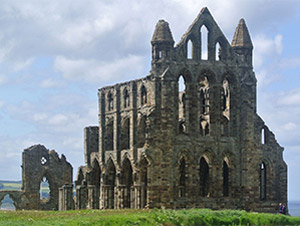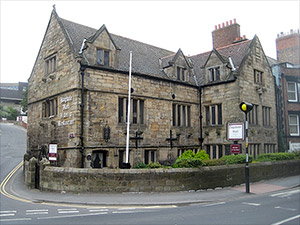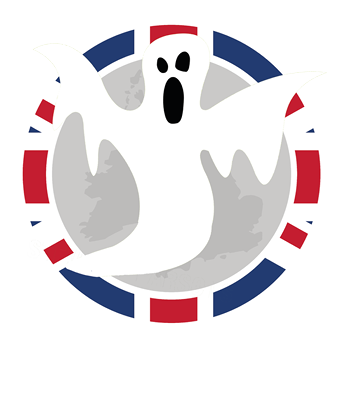Whitby, North Yorkshire, England
A view of Whitby from the harbour
Whitby Abbey

The ghost of St. Hilda reputedly haunts the grounds of Whitby Abbey, and has “been sighted on many occasions”. She is described as being “wrapped in a shroud” and appears in one of the highest windows.
There is also a legend that Hilda forbade seagulls from flying over the grounds of the Abbey, and those that do “dip their wings in respect”.
There is also the story of the ghost of a young nun named Constance de Beverley haunting the ruins, but this is believed to stem from the fictitious poem Marmion by Sir Walter Scott.
Hidden treasure is reputedly waiting to be found in the grounds, and two unscrupulous treasure hunters were disturbed in their search one night by a “headless figure clad in white”. Needless to say, they both left in a hurry!
Audible phenomena reported in the vacinity of the Abbey include the expected sound of bells and choir singing. Some have reported the latter phenomena on Christmas Day. There are also legends associated with the ringing of the bells.
Pictured left is Whitby Abbey courtesy of Wilson44691.
Abbey Lane,
Whitby,
North Yorkshire,
YO22 4JT.
For further information, please read Haunted Whitby by Alan Brooke; Britain's Haunted Heritage by J A Brooks; Haunted Britain by Antony D. Hippisley Coxe and Haunted Britain and Ireland by Richard Jones.
Aislaby Hall
Aislaby Hall was built in the mid 18th century for one Thomas Hayes, and is situated three miles from Whitby. It is reputedly haunted by a ghost in rustling silk and a phantom carriage.
For further information, please read Haunted Whitby by Alan Brooke, Haunted Britain by Antony D. Hippisley Coxe.
Bagdale Hall

Bagdale Hall is a former Tudor Manor House, which was built in 1516 for the Conyers, who were at the time one of the most important familys in Whitby. It is now a hotel.
James Conyers, bailiff of Whitby lived in the Hall until some time after his being appointed Sergeant-at-Arms to King Henry VIII. It was subsequently passed down through the family and then sold to Nicholas Bushell.
It is reputedly haunted by the ghost of Browne Bushell, a 17th century owner of the Hall who was executed for piracy.
His apparition has been sighted walking down the staircase. Phantom footsteps, children's voices and objects being moved have also been reported.
Pictured left is Bagdale Hall courtesy of Mike Kirby.
1, Bagdale,
Whitby,
North Yorkshire,
YO21 1QL.
For further information, please read Haunted Whitby by Alan Brooke; Haunted Britain by Antony D. Hippisley Coxe and Haunted Britain and Ireland by Richard Jones.
The Beast of the Bay
The Barguest, a large spectral hound, has long been associated with the Northeast of England. However, the Whitby Gazette has catalogued a series of sightings of a "panther-like creature stalking the area around the abbey" as well as in the general 5-mile radius of the town. These places include Robin Hood's Bay, Egton, Fylingdales and Runswick to Sneaton. There are numerous stories of such a creature sighted around the area as well its howls echoing across the town.
For further information, please read Haunted Whitby by Alan Brooke.
East Cliffs
The East Cliffs are haunted by a spectral "coach-like funeral hearse pulled by black horses... lit by burning torches and driven by a phantom horseman". The coach would appear in the churchyard, then make its way through Henrietta Street towards the cliff top, before plunging into the sea.
For further information, please read Haunted Whitby by Alan Brooke, Haunted Britain by Antony D. Hippisley Coxe and Britain's Haunted Heritage by J A Brooks.
Fitz-steps
The area known as Fitz-steps, located on "the fieldpath from Prospect Hill to Ruswarp", is haunted by an apparition with its head under its arm.
For further information, please read Haunted Britain by Antony D. Hippisley Coxe.
Hob
According to Coxe, the mischevious ghost named "Hob" causes motorists to skid and moves signposts around. No specific locations are given for this spectre.
For further information, please read Haunted Britain by Antony D. Hippisley Coxe.
Love Lane
According to Coxe, at the end of Love Lane there is a Wishing Chair.
For further information, please read Haunted Britain by Antony D. Hippisley Coxe.
Ruswarp and Sleights
According to Coxe, a spectre named "Goosey" haunts the area between Ruswarp and Sleights.
For further information, please read Haunted Britain by Antony D. Hippisley Coxe.














